|
 |
The concept of order, disorder, and reordering is central to my work. Scientists talk of order and randomness, of entropy, and of eternity's eventual end when all differences disappear. Yet, I am an optimist. I see life as an anti-entropic force for order. In my work, I constantly propose not a duality of life and death, but an endless cycle of life, death, and rebirth.
I explore systems of knowledge by translating philosophical concepts into aesthetic visual experiences.
My paintings honor differences among cultures by utilizing symbols and words that represent concepts shared by people of widely different philosophic worldviews. I hope that, by exposing people to the beliefs of others and by showing the interconnectedness of one belief system to another, each of us may experience a common compassion.
I studied many systems of knowledge during the last forty years, both ones well known and those more esoteric; incorporating these teachings into my life and into my art is an evolving process.
I work in series, beginning a new series with an entirely different visual approach after I solve the aesthetic challenges of my then current series. I investigate the healing potential of images in all my series, often employing pilgrimage and other ritualistic acts in the creation processes. I use word and/or myth-like visual elements from many philosophic and religious systems (including Native American healing practices, Buddhism, Christianity, Taoism, the I-Ching, Jewish mysticism as taught in the Cabala, and the chakra system of Hinduism) in order to facilitate communication with viewers on both conscious and unconscious levels.
The "Word" in Paint
Often, I purposely "hide" words in paintings. Words may be seen behind the paint and, sometimes deciphered, in whole or part; however, viewers can not conciously read the "word/Word." One reason for hiding words, phrases and symbols behind paint is that I believe art works on the Jungian unconsciousness, conscious knowledge not being required. Viewers may recognize a message lays buried behind the paint, but that message remains unreadable in its entirety, even when examined closely. Anyone who consciously tries to "get the message" will not. Yet, in this striving, I believe viewers will succeed unconsciously . . . one of the many mysteries of life and art.
I first inserted a literal "Word" into my art in 1993 in a series A Verse for the Eleventh Hour (1993) employing the poem The Second Coming by William Butler Yeats. A related series, A Story for the Eleventh Hour (1993), includes words and symbols within the paintings and, importantly, references to the poetry of T. S. Eliot, particularly Burnt Norton (one of The Four Quartets) and The Waste Land. |
Beginning with the Shen Qi series (1996-1999), I placed symbols in such a manner that they might be seen, but were obscured. In Shen Qi and its closely related, following series, States of Change (1999-2001), these symbols alluded to universal sources of human wisdom.
|
|
C S 4 Worlds: Shen Qi example that derives from Cabala visualizing the Cabalistic Scheme of the Four Worlds, a transformstion from the Tree of Life |
|
Chakras: States of Change example that superimposes the chakra system of kundalini-yoga and the Tree of Life |
|
Om mani padme hum: States of Change example that uses the Sanskrit phrase om mani padme hum |
|
Yellow River Map: States of Change example that includes the Yellow River Map (Ho T'u in Chinese) derived from The Book of Changes (I Ching or Yi Jing in Chinese) |
During the development of the next two series, Visible Reminders (2002-2003) and Tree of Life (2002), I incorporated phrases and symbols from Cabala and the bible into the paintings. Increasingly, the ability to read the written message within the painting is obscured as these two series develop. |
|
VR and Tree of Life: Comparison between one Visible Reminders painting with words from T.S. Eliot and one Tree of Life series |
| All works from The Fire and the Rose (2003-2005) are titled with words from Little Gidding (one of The Four Quartets by T.S. Eliot) and all the larger painting hide lines of poetry from Little Gidding within the paint. The written "message" may not be read while viewing these works as that message purposefully remains obscured to the conscious mind. |
My latest series, The Thirteenth Moon (2005-2006), evolves as I continue exploring painterly methods of visualizing different philosophic systems of human experience. The overall visual appearance of the work in this series changes significantly, even though the concept of order, disorder, and reordering continues. At the beginning of this new series, I persisted in disguising words behind the paint within central area of the painting.
|
| I used words from a poem by William Butler Yeats, The Phases of the Moon (1937). Yeats described his philosophic system in A Vision (1925; 1937). In Yeats's esoteric system, all things are subject to re-occurring cycles of change, symbolized by the changing phases of the moon.
The concept of a thirteenth moon also may remind many that the annual cycle of twelve months does not correspond precisely to twelve, twenty-eight day lunar periods. The Thirteenth Moon may metaphorically be viewed as a symbol of the continuous renewing of life, since it may bridge the last portion of an old year with the first portion of the new.
But the series evolved. I moved the poetry from central area to a painted frame and began painting "symbolist landscapes" featuring the moon. |
I continue painting symbolist landscapes, but now use poetry from the two of the most famous poets of China: |
|
Li Bai (also Romanized as Li Po) |
701 - 762 A.C.E., Chinese |
|
Du Fu (also Romanized as Tu Fu) |
712 - 770 A.C.E., Chinese |
| Visualizing the words themselves in the frame now became part of the painting. Twelve centuries after the words were written, they still convey a profound understanding of life. |

© 2006
ID #686 |
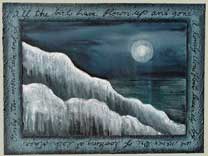
© 2006
ID #687 |
Beth Ames Swartz
The Thirteenth Moon:
The birds have vanished down the sky
acrylic and paste on canvas
36" x 48" (0.91m x 1.22m)
2006
|
Beth Ames Swartz
The Thirteenth Moon:
All the birds have flown up and gone
acrylic and paste on canvas
36" x 48" (0.91m x 1.22m)
2006
|
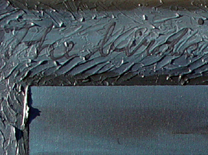 |
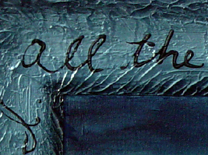 |
"The birds have vanished down the sky.
Now the last cloud drains away.
We sit together, the mountain and me,
until only the mountain remains." |
"All the birds have flown up and gone;
A lonely cloud floats leisurely by.
We never tire of looking at each other –
Only the mountain and I." |
Li Bai, also Romanized Li Po,
701 - 762 A.C.E., Chinese)
Translated by Sam Hamill
A Drifting Boat, edited by J.P. Seaton and Dennis Maloney, Fredonia, NY.: White Pine Press, 1994) [38] |
Li Bai, also Romanized Li Po,
701 - 762 A.C.E., Chinese)
Translated by Sam Hamill
A Drifting Boat, edited by J.P. Seaton and Dennis Maloney, Fredonia, NY.: White Pine Press, 1994) [38] |
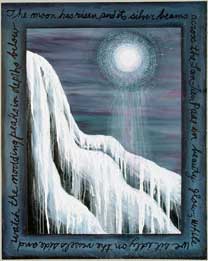
© 2006
ID #696 |

© 2006
detail of ID #696 |
Beth Ames Swartz
The Thirteenth Moon:
An hour of changing scenes
acrylic and paste on canvas
60" x 48" (1.52m x 1.22m)
2006
|
Words from the last three stanzas of a poem by Du Fu encircle the moon and "ray-down" upon the earth. |
"The moon has risen, and its silver beams
Across the Lan-Tien Pass in beauty glow,
While we sit idly on the vessel's side
And watch the nodding peaks in depths below"
Du Fu, also Romanized as Tu Fu,
(712 - 770 A.C.E, Chinese)
from The Waters of the Mei-Pei, trans. Budd, Charles |
"In ecstasy we watch the wondrous scene,
But awe and joy are mingled in our mind,
For now far off we hear the thunder peal,
And lowering clouds with lurid lights are lined. The waters heave with burdensome unrest,
The air is full of shadows of the dead;
The Spirits of the Universe are near,
And we cannot divine their portents dread.
And such is life—an hour of changing scenes
Of fitful joy and quickly following grief;
An hour of buoyant youth in rapid flight,
And then old age to end life—sad and brief!"
|
|
|
May the Word be Visualized?
Ancient Jewish tradition requires that the name of God not be written. Many other faiths preach that the name of God not be used in an inappropriate manner.
Most frequently, I have "hidden" symbols or the “Word/word” in the sense that a viewer may recognize something appears within the visual field; however, even when an individual word may be discerned, the message may not be read. |
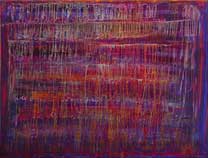
© 2001
BASID #431 |

© 2001
detail of BASID #431 |
Beth Ames Swartz
Visible Reminders:
Muted Light
acrylic on canvas
48" x 60" (1.22m x 1.52m)
2001
|
"We must be fully alive in the present moment to experience the divine." |
|
|
Allowing the word in paint to become more apparent (as in my latest series, The Thirteenth Moon) raises the possibility that viewers/readers holding one belief system may feel that art alluding to a different belief system confronts their beliefs. When I allow the "word" to be visually recognized, using poetry rather than wisdom from a specific belief system helps convey the underlying wisdom in a non-confrontational manner. Visualizing the word also honors the great Islamic calligraphic tradition wherein the Word may be visualized, but where representational renditions may not be acceptable.
Frames, Grids and Gestures
I began employing painted frames with A Story for the Eleventh Hour (1993) by applying material along the edge of the shaped canvas used for paintings in this series. The "painted frame" reinforced the themes of cosmological and spiritual journeys of being by creating a window from which the viewer may look out into the universe and inward into themselves.
I continued using shaped canvas and golden-edged "frames" with Shen Qi (1996-1997) and States of Change (1999-2000); however, I began organizing the central area of the painting as a grid. (The use of a grid, while pre-dating modern art, reflects the thinking that, " . . . before a painting is a painting, it is a piece of canvas.”). The golden "squares" applied in grid fashion create order, an order that is counterbalanced by the chaos and randomness of the disorder created by violating the form of the individual golden squares. |
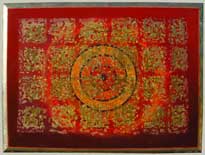
© 1997
BASID #152 |
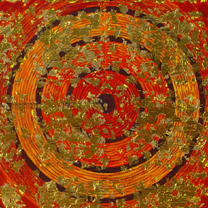
© 1997
detail of BASID #152 |
Beth Ames Swartz
Shen Qi:
The Cabalistic Scheme of the Four Worlds #3
mixed media with gold leaf on shaped canvas
36" x 48" (0.91m x 1.22m)
1997
|
The outer frame of gold leaf over a shaped (i.e., three-dimensional) canvas creates an appearance of order as do concentric circles and the grid of six by four gold “squares.” The gold squares, however, are composed of very chaotic smaller pieces Overall, an image of order, disorder and reordering |
|
|
| With the series Visual Reminders (2001-2002), I created a grid of seeming order by hiding words in horizontal lines along with horizontal bands of color that were further ordered (and disordered) by vertical, seemingly random, drips: |

© 2001-2002
BASID #437 |
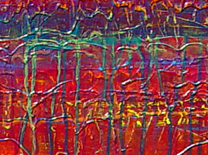
© 2001-2002
detail of BASID #437 |
Beth Ames Swartz
Visible Reminders:
In my end is my beginning
acrylic on canvas
48" x 72" (1.22m x 1.83m) 2001-2
|
Order created by horizontal bands of color over the horizontal words. Disorder created by seemingly random vertical drips. Reordering created by the grid formed by the horizontal and vertical elements. |
|
|
In Tree of Life (2002), I painted a frame upon the canvas; by the time of The Fire and the Rose (2003-2005) series, the painted frame "binds" and "orders" the apparently "disordered" interior to this central “window” wherein the seeming order created by horizontal “rows” of hidden words and horizontal paint strokes may be disordered by seemingly random vertical drips.
In many of the later works of The Fire and the Rose, fluid, gestural brush strokes violate any appearance of order, thereby adding energy by visually generating an illusion of ordering (by the grid of ordered horizontal lines and vertical drips), disordering (by the gestural strokes), and reordering (by the painted frame). |
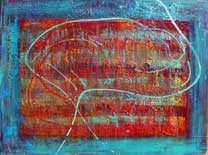
©2002-2004
BASID #590 |
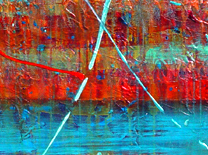
©2002-2004
detail of BASID #590 |
Beth Ames Swartz
The Fire and the Rose:
While the light fails on a winter's afternoon, in a secluded chapel
acrylic on canvas
36” x 48” (0.91m x 1.22m)
2002-2004 |
Fluid gestural strokes violate the order imposed by the painted frame “freeing” the interior grid and, once again, establishing an ongoing dialogue between order, disorder and reordering. |
|
|
Whither Thou Goest?
Order, disorder, reorder. |
|
|
|



